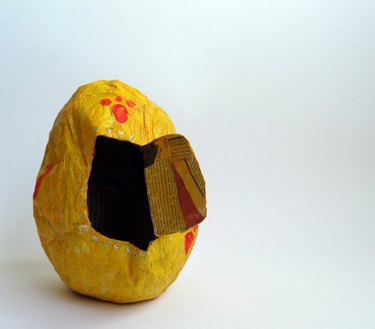
The beauty of creating crafts with paper mache is it requires no special supplies -- the items you need to make your projects are probably already in your home. While the recipes for paper mache paste are numerous, the simplest requires nothing more than paper, water and regular white glue.
Glue-Based Paper Mache Paste Recipe
Video of the Day
Mix equal parts white glue and water in a disposable container, such as a plastic take-out soup container. Stir thoroughly to mix the ingredients well. If you want to save some of the paper mache paste for later in the day, select a container with a lid. The ratio of water to glue need not be exact -- if you prefer a slightly thinner paste, add more water. Add more glue for a thicker paste. To save money, use an inexpensive off-brand school glue rather than a pricey craft glue.
Video of the Day
Pasting Preparation
Cover your project area with a plastic tablecloth or wax paper to protect it from paste drips. Newspaper isn't ideal in this case because the paste may stick your project to the table covering. Set an empty disposable tray or pie tin on the work area; this comes in handy for dipping the paper strips, if you're working with long pieces of paper. A shallow bowl of water allows you to rinse off your fingers or rubber gloves if they become too sticky while working.
Paper and Project Supplies
Paper is the other key supply needed for paper mache, along with the paste. Newspaper, old phone book pages, flyers and junk mail all work well because the paper is thin enough to conform to your project's shape, but not so thin that it tears easily. Tissue paper, for instance, would not work well for the basic layers because it's so thin, but you could use it to add color as the final layer or two on your project. Tear the paper into strips 1/2 to 1 inch thick. The length depends upon the size of your form -- several inches long works well for the average balloon. As for project forms, a balloon is ideal, because it can be popped after the paper mache dries. Set a balloon on a bowl or roll of masking tape to keep it in place. You could also wrap an object such as an upturned bowl with plastic wrap, and paper over the plastic wrap. There's a slight chance the plastic will stick to your project unless you use wet paper, rather than pasted paper, for the first layer.
Papering Your Project
Dip a strip of paper into the paste container, or pour some of the paste into a shallow tray if you prefer wider access to the paste. Pull the paper out, and then run it between your fingers to remove excess paste. Wear rubber gloves if you don't want the glue on your hands. Smooth the strip onto the balloon or project form somewhere near the top. Repeat the process with a second strip of paper, crossing the first at an angle. Continue covering the form, crossing one piece over the last each time until the entire project is covered. Smooth out any ripples or raised paper edges as you see them.
If the project is so large you can't finish it all at once, that's fine -- new paper mache can be applied atop dry or partially dry paper mache. Once the first layer dries completely, apply another layer. Squeeze the project gently once the second layer dries to get an idea how hard or flexible it is. If it feels sturdy enough, pop the balloon with a needle and remove the balloon, if you used one. Apply more strips of paper over the hole area to cover it. If you're working with a bowl or solid form, remove the dry paper mache from the form and peel it away from the plastic wrap. Trim edges on shapes such as bowls with scissors or a craft knife. Add more layers as desired for a thicker, sturdier piece.